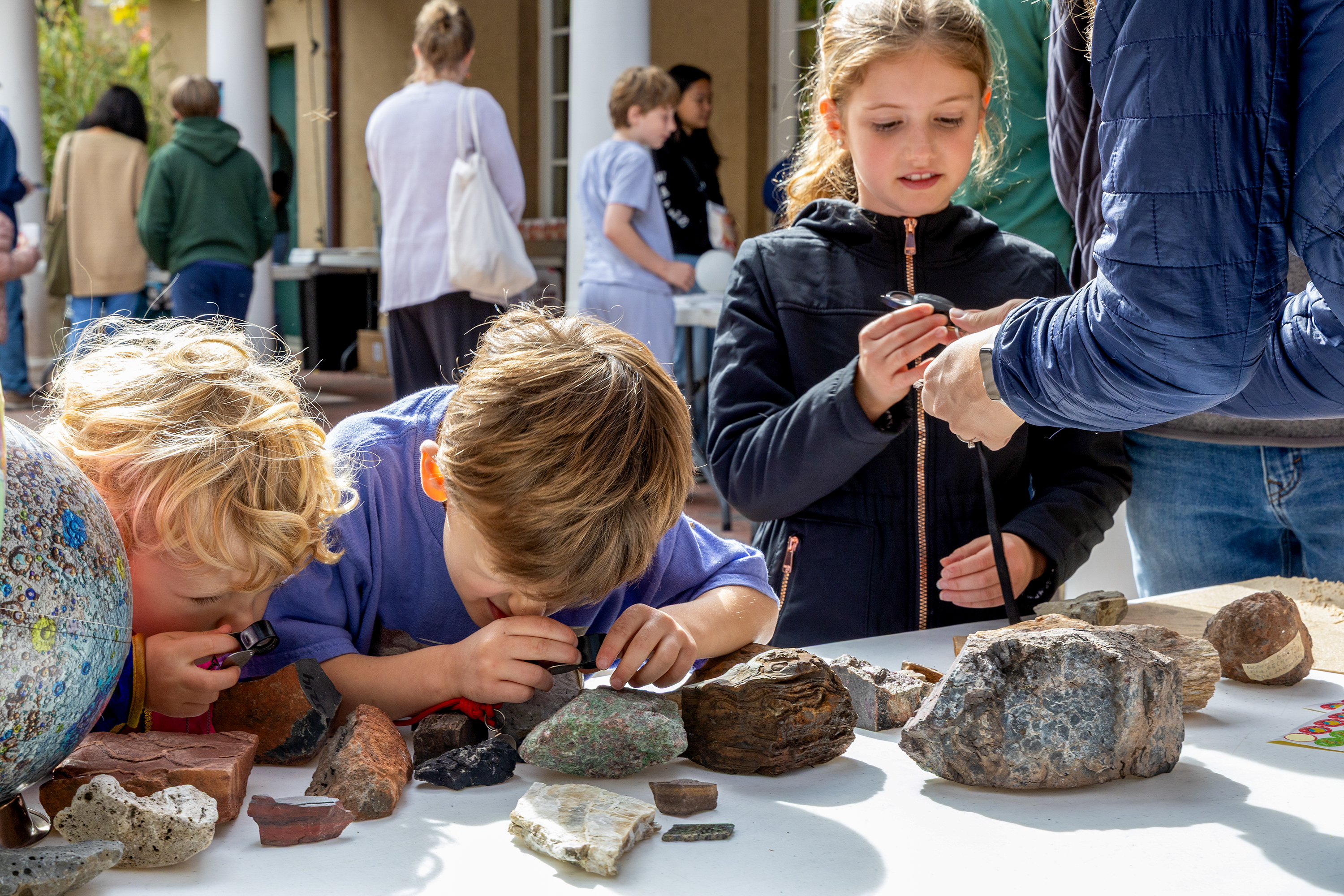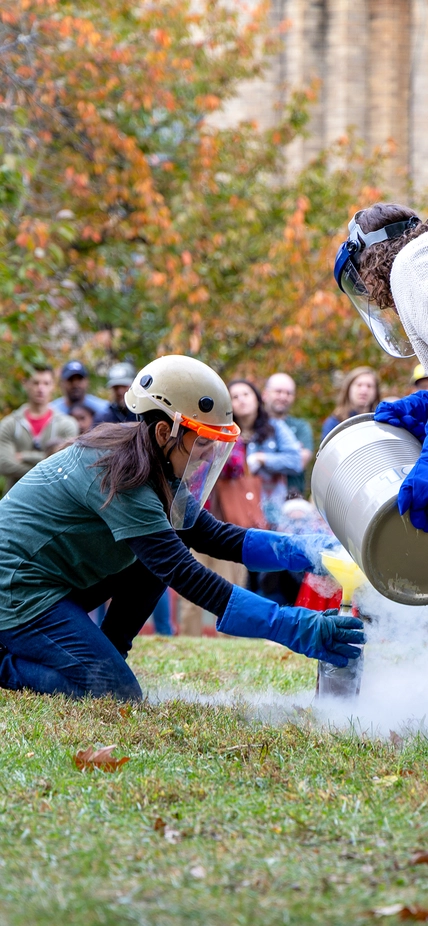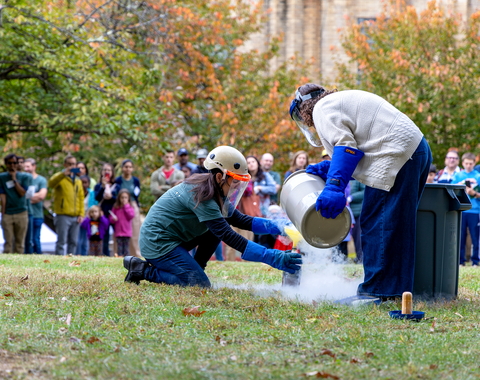You could have heard a pin drop on the grassy courtyard in the middle of Carnegie Science’s Earth & Planets Laboratory on October 25 as anticipation of the “Trash-cano’s” impending explosion grew. Postdoctoral fellow Andrea Goltz, an experimental geochemist, had just finished explaining to the visitors lining the perimeter how pressure builds up in volcanos before they erupt, then she pulled down her safety mask and began to carefully measure out a precise amount of liquid nitrogen with the help of Staff Scientist and volcanologist Diana Roman. They poured it into the can, then quickly stepped away.
“There will be a little bit of a delayed reaction,” Goltz warned, and within a minute more than a hundred ping pong balls burst from the mouth of the can with a boom, and hundreds of science enthusiasts—spanning nearly nine decades in age— erupted with their own cheers and applause. When the all-clear was given, the youngest and fastest ran onto the lawn, collecting the balls and eagerly waiting for the “Trash-cano” to erupt again an hour later.
The “Trash-cano” was one of 15 installations at EPL’s inaugural Open House, which brought more than 500 learners of all ages to the campus for hands-on scientific exploration. Though the Carnegie Science Observatories in Pasadena have long welcomed Southern Californians to the campus each fall, this was the first Open House offered by EPL, expanding on traditional public outreach efforts in the Washington area, like the hallmark Neighborhood Lecture Series. It was a group effort months in the making, and brought more than four dozen volunteers from across Carnegie’s scientific and administrative staff functions together in what was, according to neighbors and attendees, a rousing success.

“It fills my bucket to see how much the kids enjoyed it and were pumped about science,” said one EPL neighbor, Emmanuelle Salvatore. “Even my cynical 12-year old said it was ‘sick.’”
There was something for everyone at the Open House, which showcased the broad scientific expertise and professional skills represented on the EPL campus, as well as the unique tools and processes deployed in our research. EPL scientists study the processes that shape our own and other planets across a range of fields, including mineralogy, geophysics, geochemistry, astronomy, materials science, and more. Their work spans scales from the atomic to the cosmic. And Open House attendees experienced that scope firsthand.
Staff Scientists Timothy Strobel and Jennifer Kasbohm respectively demonstrated how researchers use diamond anvil cells to mimic extreme pressure inside Earth and isotopes found in rocks to decode the planet’s history. Postdocs Sierra Grant and Shubham Kanodia joined Staff Scientist Alycia Weinberger to showcase how light is used to study far-away stars and galaxies, and helped attendees build their own personal spectrographs. Neighbors also witnessed the power and beauty of extraordinary minerals from Earth and space by constructing chemical gardens with postdoc Michael Wong, and held stardust with the assistance of Staff Scientist Conel Alexander and Electron Microprobe Lab Manager Emma Bullock. They learned about the shifting nature of Earth’s surface from postdoc Kevin Wong, envisioned magma oceans with Staff Scientist Peter Driscoll, and examined a rock sourced directly from Mars with Staff Scientist Andrew Steele. They hunted for ancient shark teeth, and witnessed the surprising material properties of everyone’s favorite non-Newtonian fluid, oobleck, with computational scientist Cian Wilson.
But the installations weren’t only for seeing, hearing, and touching, they were also for tasting. EPL Director Michael Walter showed that the extreme freezing properties of liquid nitrogen can flash freeze cream (more than 25 quarts of it) to make a delicious ice cream treat. On the other end of the temperature spectrum, Observatories Outreach Coordinator Jeff Rich—”on loan” from the West Coast—and postdoc Nicole Wallack seized on periods of clear weather to demonstrate how the sun’s rays can be concentrated with a mirror to harness sufficient heat to toast a marshmallow. Similarly, popcorn and cotton candy stations showed the transformation of corn and sugar into other forms from heat exposure.
“Our Neighborhood Lecture Series has long been our primary opportunity to connect with the people who live in and around our EPL community,” said Walter. “The Open House was a special opportunity to demonstrate our science on a larger scale, and to show that no matter what age or experience level a person is, they can take part in scientific exploration too. I heard from a few people that they’d passed by EPL for many years, but didn’t know much about our work. I hope the Open House is a turning point in that regard. We’re already looking forward to next year, and it seems like those who came out and joined us are, too.”

In addition to the hands-on experiments and experiences, attendees also took part in “lightning talks” that shed light on the work of EPL’s scientists and the historic figures who have advanced discovery within our labs, like Vera Rubin, who confirmed the existence of dark matter. Librarian emeritus Shaun Hardy and Archivist and Digital Asset Manager Maggie Drain were on hand to explain the significance and purpose of our various facilities, including the “Atom Smasher,” a 3-million volt particle accelerator that was the first to demonstrate uranium fission in the United States in 1939. Elsewhere, Staff Scientist Yingwei Fei showed off our Large Press Lab, where scientists use piston-cylinder presses to recreate the intense heat and pressure found deep within planets, and Staff Scientist Lara Wagner demonstrated how the Seismology Lab is used to study vibrations in the Earth that allow researchers to “see” within the layers we cannot access from the surface.
“We’re a STEAM oriented household, and it’s been magical to watch my three-and-a-half year old running around pretending to explode, ‘like that trash can that blew up like a volcano and then we got to run and get the balls!’,” said attendee Lauren Kitces. “We’ve heard of how ‘Lara showed me how to be an earthquake!’ And, ‘Emma let me hold pieces of space! Like the asteroid belt! And Mars!’ and, ‘my friend and I got to see where they smash atoms!’ Meeting scientists, seeing and experiencing science in a unique environment, and getting cotton candy (obviously) was so incredible to…one self-identifying ‘little scientist,’” Kitces added.



